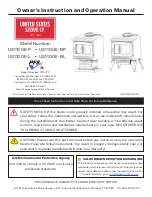
16
Clearances to Walls & Ceilings
The following clearances have been tested to ULC standards and are the minimum clearances
specifically established for the Sedore stove.
Front—48”
Back—18”
Sides—42”
Flue Pipe—18”
A combustible surface is anything that can burn (i.e. sheet rock, wall paper, wood, fabrics etc.).
These surfaces are not limited to those that are visible and also include materials that are behind
non-combustible materials.
If you are not sure of the combustible nature of a material, consult your local fire officials. Contact
your local building officials about restrictions and installation requirements in your area.
Remem-
ber:
“Fire Resistant” materials are considered combustible; they are difficult to ignite, but will burn.
Also “Fire-rated” sheet rock is also considered combustible.
Using Shields to Reduce Clearances
Pipe shields: When using listed pipe shields to reduce the connector clearance to combustibles, it
must start 1”(25,4mm) above the lowest exposed point of the connect pipe and extend vertically a
minimum of 25” (635mm) above the top surface of the stove.
Double wall pipe: Listed double wall pipe is an acceptable alternative to connector pipe heat-
shields.
Wall-Mounted Protection: When reducing clearances through the use of wall mounted protection:
refer to CAN/CSA-B365, Installation Code for Solid-Fuel Burning Appliances and Equipment, also
for acceptable materials, proper sizing and construction guidelines.
Note: Accessories for wood stoves for clearance reduction have been developed by many manu-
facturers. If not following the methods of the installation codes, be sure that any accessory you
choose has been tested by an independent laboratory and carries the laboratory’s testing mark.
Make sure to follow all of the manufacturer’s instructions.
















































